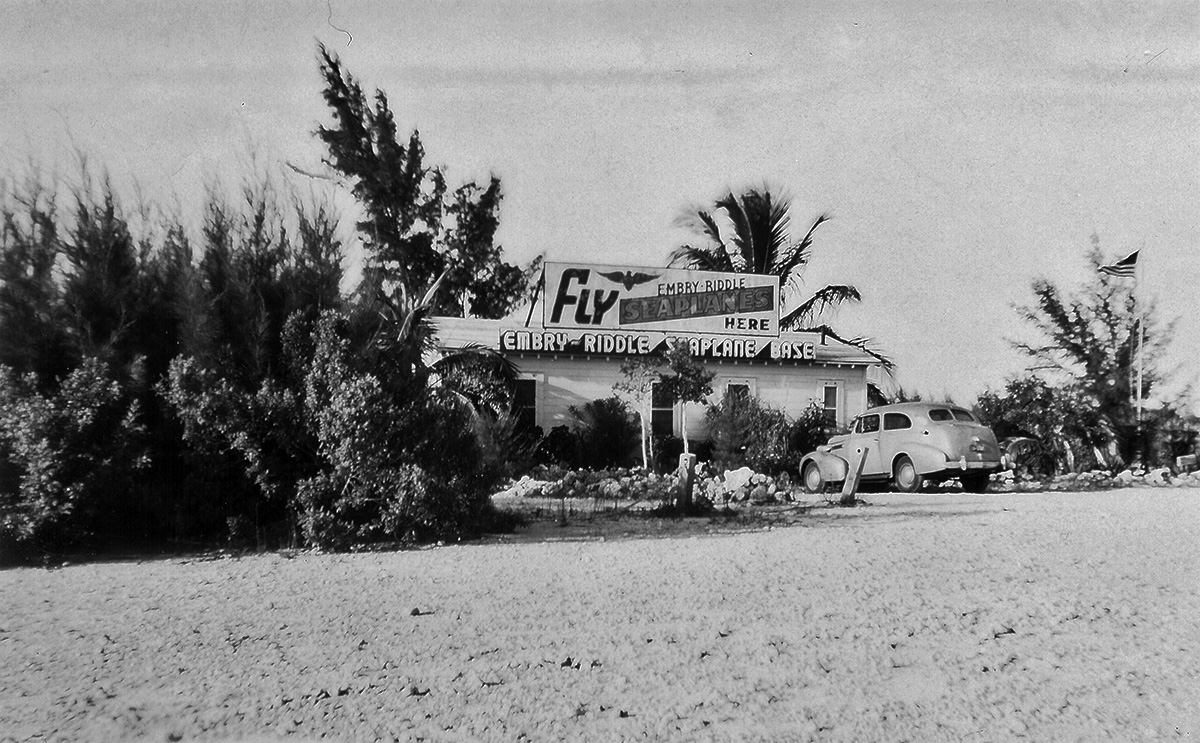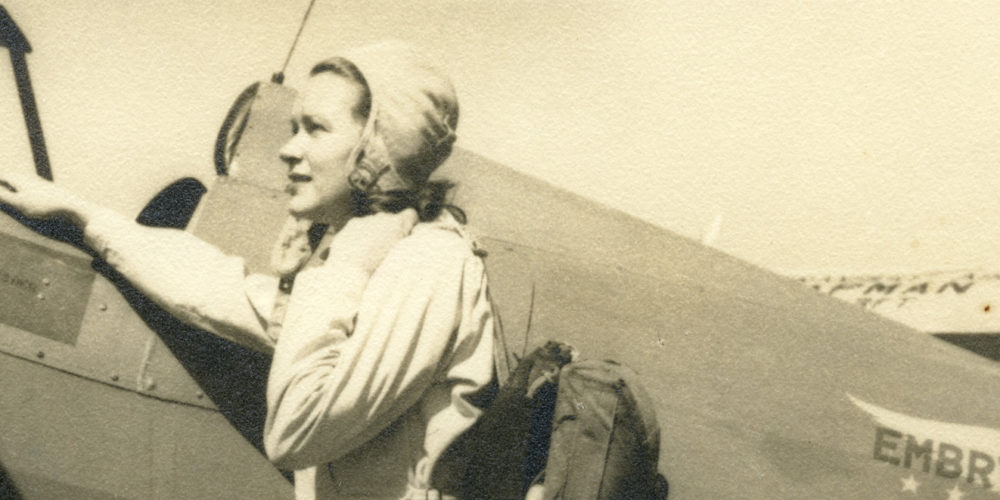Around 1929, on a small, grass airstrip in Ottumwa, Iowa, a father and his 10-year-old daughter took a ride in a replica of The Spirit of St. Louis. That short flight ignited a passion for aviation that eventually led Corinne Louise Smith (’42, MC), née Phillips, to Embry-Riddle’s Seaplane Base in Miami.
Smith had wanted to join the Civilian Pilot Training Program while pursuing a bachelor’s degree in English at Northwestern University. Her parents shot down the idea.
But the desire to fly never left her.
“When I finished college and went to Miami to make my way in the world, the first thing I did was to try and get into flying,” Smith says.
Babs Beckwith, whose brother Smith had dated, told her about Embry-Riddle. Beckwith had earned a pilot’s certificate, worked as a flight instructor and even modeled for promotional materials at Embry-Riddle. “She [Beckwith] encouraged me to get going!” Smith recalls.
Out on the Causeway
Smith started flying lessons in December 1941 at the Embry-Riddle Seaplane Base, a sparse, one-building facility with a dock on MacArthur Causeway. Embry-Riddle co-founder John Paul Riddle operated the facility in partnership with Miami lawyer and investor John McKay. When it opened in the summer of 1939, it had just two Piper planes, a 40 horsepower Silver Cub and a 50 horsepower J-3 Cub, but the fleet quickly grew to six.
“There was a little building, just one room and a few aircraft. It was the very beginning when I came there,” Smith recalls.

Did You Know?
The seaplane base in Miami represented a revival of the Embry-Riddle name. John Paul Riddle and his former partner, T. Higbee Embry, had merged their holdings with the Aviation Corporation, or AVCO, 10 years earlier in 1929. As part of the agreement, they promised to retire the company moniker for a decade. Riddle had a fondness for the former name, and in 1939, he branded the seaplane base with it (and all of his future flight training operations). Embry was not a party to any of Riddle’s business endeavors after 1929. Find out more at erau.edu/archives.
She got a job there as a secretary, in order to pay for her training. “I was working for Mr. [Ed] China in the purchasing department so I could make the $6 an hour I needed to fly,” she says.
Smith completed her first solo flight in July 1942. “It was only a matter of seconds when I was skimming the bay waters and into the clear blue sky — all alone,” Smith says.
The Embry-Riddle Fly Paper, the company newsletter, commemorated the event with a photo of Smith sitting in the cockpit of a Piper J-3 Cub, grinning proudly. The front-page story congratulated her as “another ‘Woman with Wings’ in the Embry-Riddle ‘family.’”
‘Family’ Ties
Smith was actually ingrained with the “family” in multiple ways. She spent time with Riddle while she was training and working in Miami, and later she became good friends with Frances Embry, after Frances’ husband and Embry-Riddle co-founder, T. Higbee Embry, passed away.
“John Riddle was so nice. If you wanted to see him at his office, there was no problem whatsoever getting an appointment with him. I knew his secretary quite well, and she was the same way. It was very open, very friendly. It was just like one big home,” Smith remembers fondly.
Riddle invited Smith and other women employed at Embry-Riddle to act as hostesses at the receptions he would throw for men enlisted in the U.S. Army Air Forces. “John Riddle entertained so beautifully for the servicemen at his villa on Miami Beach,” Smith says.
A Woman’s Place Is in the Air

As the school grew and took a bigger stake in the war effort, Smith’s role grew with it. In July 1943, having earned pilot certificates for both land and sea, Smith got a promotion. She and three other women were working as instructors on Link trainers, an early type of simulator for instrument flying. When Chief Link Instructor Buzz Cooper was called to military service, Smith was the obvious successor; with that change, the Link division was operated entirely by women.
Smith says her gender was never a hindrance there. In fact, Embry-Riddle had a large complement of women instructors, as well: no fewer than 17 worked there in 1943.
Head in the Clouds
Smith left Miami and Embry-Riddle in 1944 with a flight instructor and commercial pilot certification to her name. She went on to flight instruct in California, then New Jersey and New York, but had one special pupil in mind. “While I was still an instructor, I took my father up for his first flight lesson, and he went on to get his pilot’s license,” she says.

At age 28, Smith married a Navy pilot. He died in a plane crash just three years later, but she would eventually find her “daredevil” second husband — a former P-51 pilot — who led them on many more air adventures. “He would fly anything he could get his hands on, like a Johnson Rocket,” she says. “We didn’t keep it very long.” The high-performance monoplane was known for being fast and rather dangerous, and the couple had a 3-year-old daughter at the time, she explains.
Throttling Down
Smith now lives in Vero Beach, Fla., where she has found friends in the flying community and at the Piper Aircraft headquarters. Bambi Miller, coordinator at the Piper Pilot Shop, describes Smith as something of a celebrity at Piper.
At 98 years of age, Smith is searching for a small model of a Piper J-3 Cub seaplane, like the one she soloed in so long ago. Through all of her experiences, Smith still carries a fondness for those Piper Cubs on floats: “I love the sea. We’ve lived on boats, and I’ve been on water a lot of my life. I love the seaplane for that reason.”
EDITOR’S NOTE: Embry-Riddle at War, authored by Embry-Riddle Historian Stephen G. Craft (2009), and the University Archives, erau.edu/archives, were sources for this article.
